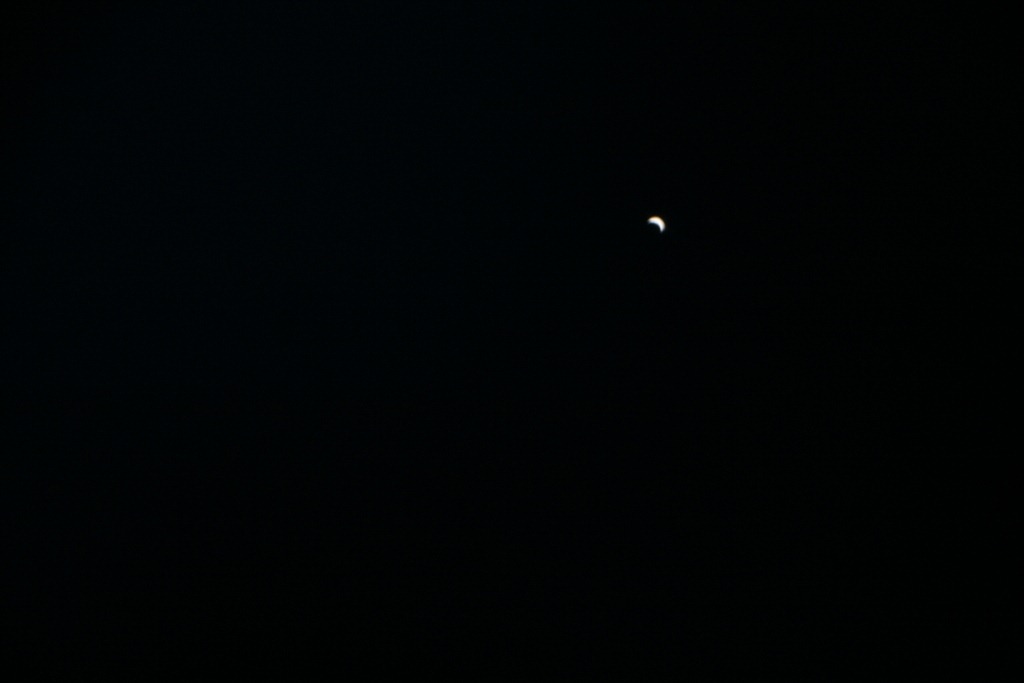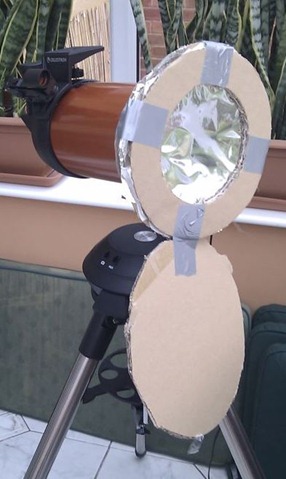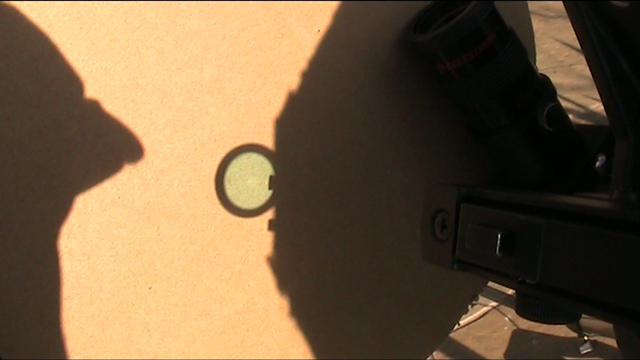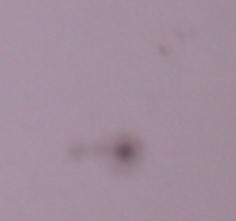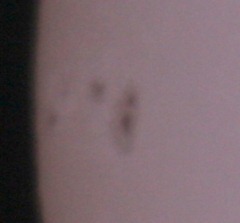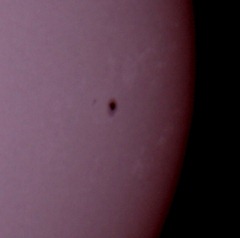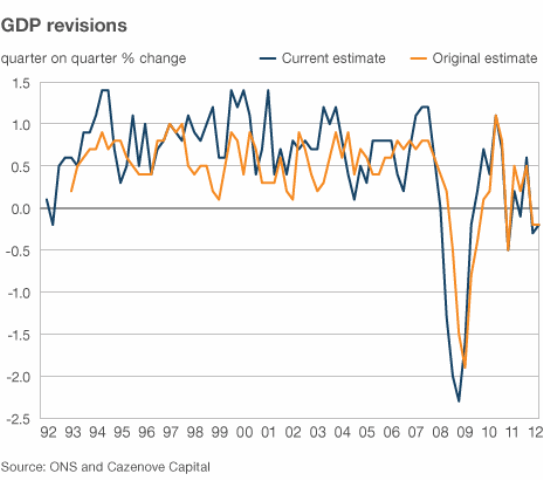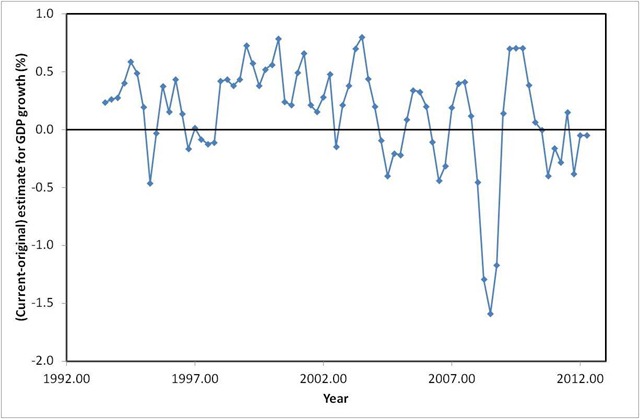Author's posts
May 13 2012
The sky at night!
And so after 10 days, I finally had a chance to play with my new telescope on Friday night! Optical astronomy requires at least a few gaps in the clouds but last night at 8pm it was completely clear – I was hopping up and down like an overactive child waiting for the sun to go down (scheduled for about 8:40pm) and simultaneously cursing the slightest wisp of cloud. It should be clear that I’m a bit new to this, so what I write shouldn’t be seen as in the slightest bit authorative.
Kindly folk at @newburyastro had suggested Venus and Saturn as targets for my first adventure into the night. Useful advice because, as a relative beginner I had little idea what I was going to see, or in fact when I was going to see it. Venus become visible at about 9:20pm towards the now-set sun, it turns out that pointing the ‘scope with the finderscope is much easier than the rather more hazardous enterprise of finding the sun without (something I describe here). In the eyepiece Venus appears as a small, bright crescent.
It was a breezy evening which meant that my view jiggled about a bit, it also jiggled about a bit whenever I touched the telescope. However I did manage a picture of Venus taken on my Canon 400D at prime focus. This is an uncropped view, and it’s upside down.
Mars made an appearance a little later at about 9:35pm along with a bright star which I believe is Regulus. This enabled me to get my telescope to work out how it was orientated meaning it could track to objects on demand and also tell me what I was looking at (very handy for a novice). My picture of Mars is a little uninspiring, I’ve zoomed in here as far as possible, in Mars’ favour it does look red and it isn’t a simple point.
By now more and more stars were coming out, so I thought I’d try out my piggyback mount. This image is taken with a 10mm lens (i.e. really wide angle) with the telescope simply used as a camera mount pointed at Polaris, it’s a 30s exposure.
It took a while to get this because I had auto-focus on and the camera couldn’t find anything to focus on so wouldn’t fire – switching off auto-focus and focusing to infinity manually resolved this. It was at this point I wished I could remember how to switch the display on the back of my camera off because it was really bright, and remember which button was which without being able to see it. The thing that surprised me about this is that there are rather more stars than I could see with my naked eye and some of them are quite strongly coloured. I feel I should go about identifying the stars in my picture.
At this point I thought I’d give Saturn a go, I must admit I thought it was hidden behind buildings and trees from my position in the back garden but I punched it into the telescope handset and it pointed me into the side of the conservatory, so I picked up the telescope and moved it one metre to the right, peered through the finderscope and tweaked my direction a bit and… the planet with ears popped into view!! This was really exciting! I only have one eyepiece for my telescope and it’s quite low magnification but through the eyepiece I could see my target was not a point, and it was not round – it was shaped like a flying saucer and there were slight gaps either side of the central body. Having marvelled at this for a bit I thought I’d try for another photograph:
It’s not the best picture of Saturn taken last night but it is my picture!
The moon hadn’t risen before I went to bed, so when I spotted this morning I rushed out for a photo.
I’ve not done any astrophotography before these (apart from my shots of the sun, and a couple of shots at the moon through a conventional lens). I guess the thing I carried over from that was that the moon is a rock in full sun, so you need to set your exposure times accordingly, the same is true for Mars and Venus so I suspect I should be using shorter exposure times for them to which will also reduce any motion blur.
My first night of viewing has highlighted a need to have a better grip of how to work your camera, plan what you want to look at in advance and, as with an SLR camera, a telescope is simply a gateway drug for further accessory purchase.
May 12 2012
Book review: Measure of the Earth by Larrie D. Ferreiro
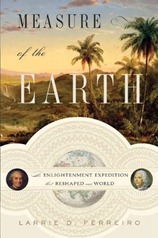 This post is a review and summary of Larrie D. Ferreiro’s book “Measure of the Earth” which describes the French Geodesic Mission to South America to measure the length of a degree of latitude at the equator. The action takes place in the 2nd quarter of the 18th century, the Mission left France in 1735 with the first of its members returning to Europe in 1744.
This post is a review and summary of Larrie D. Ferreiro’s book “Measure of the Earth” which describes the French Geodesic Mission to South America to measure the length of a degree of latitude at the equator. The action takes place in the 2nd quarter of the 18th century, the Mission left France in 1735 with the first of its members returning to Europe in 1744.
The book fits together with The Measure of All Things by Ken Alder, which is about the later French effort to measure a meridian through Paris at the turn of the Revolution in order to define the metre, The Great Arc by John Keay on the survey of India and Map of a Nation by Rachel Hewitt on the triangulation survey of the United Kingdom.
The significance of the measurement was that earlier triangulation surveys of France had indicated that the earth was not spherical, as had pendulum measurements made by Jean Richer in Guyana in 1671 which showed a pendulum there ran 2:28 slower there than in Paris. A Newtonian faction believed that the earth was flattened at the poles, its rotation having led to a bulging at the equator. A Cartesian school held that the earth was flattened around the equator and bulged at the poles, this was not a direct result of work by Rene Descartes but seems to have been more a result of scientific nationalism. Spoiler: the earth is flattened at the poles.
From a practical point of view a non-spherical earth has implications for navigation – ultimately it was found that polar flattening would lead to a navigational error of approximately 20 miles in a trans-Atlantic crossing although at the time of the Mission it was believed it could have been as much as 300 miles. Politically the Mission provided an opportunity for the French to form an alliance with the Spanish, and to get a close look at the Spanish colonies in South America which had provided huge wealth to Spain over the preceding 200 years. Ferreiro provides a nice overview of the L’Académie des Sciences under whose aegis the mission was conducted,and of the Comte de Maurepas, French minister of the navy and sponsor of the Mission.
The core members of the Geodesic Mission were Pierre Bouguer, Charles-Marie de La Condamine, and Louis Godin they were accompanied by Spanish Naval cadets Antonio de Ulloa y de la Torre-Guiral and Jorge Juan y Santacilia. Other members were Joseph de Jussieu (doctor and botanist), Jean-Joseph Verguin (engineer and cartographer), Jean-Louis de Morainville (draftsman and artist), Theodore Hugo (instrument maker), Jean-Baptiste Godin des Odonais and Jacques Couplet-Viguier.
Louis Godin, an astronomer, was the senior academician and nominal leader of the mission. Pierre Bouguer, was a mathematician, astronomer and latterly geophysicist: as well as the measurement of the degree of latitude he also attempted to measure the deflection of a plumb-line by the mass of a mountain – an experiment which Nevile Maskelyne was to conclude successfully in 1775, I wrote about this here. Bouguer also wrote a treatise on ship building whilst away in South America. Charles-Marie de La Condamine could best be described as an adventurer although he was also a competent mathematician and geographer, it was his more lively writing on life in South America which would have a bigger impact on their return to Europe.
The scheme for the determination of the length of a degree is to measure the length of a meridian (a line of longitude) close to the equator by triangulation, making a ground measurement baseline to convert the angular measurements of the triangulation survey into distances and a second baseline to confirm your workings; the latitudes of the ends of the triangulation survey are determined astronomically by measuring the positions of stars. I’ve read of this process before, the new thing I learnt was the method for aligning up your zenith sector with the meridian – which I’m tempted to try at home.
These measurements were done in the area around Quito, in modern Ecuador (named after the equator), the endpoints of the survey were at Quito in the north, close to the equator and Cuenca approximately 200 miles south. During the survey, through the Andes, the team scaled peaks as high as Mont Blanc (and suffered altitude sickness for their troubles) which would not be climbed for another 50 years. The survey was repeated in the early years of the 20th century and even then it took 7 years – the same length of time as the original survey, due to the transport difficulties presented by the terrain.
The work of measuring the meridian was made more difficult by the journey to get there (which took the best part of a year), the terrain and conditions when they got there (mountainous and cloudy), the poor leadership of Godin, local political machinations and the mother country cutting them loose financially. Ferreiro makes a lot of Godin’s poor leadership, some of which is justified – he spent Mission money on prostitutes and regarded the Mission funds as his own purse. Frequently the Mission split into two groups, one containing Bouguer and La Condamine and the other Godin – sometimes this is quite appropriate, in duplicating measurements for consistency whilst on other occasions it is simply fractiousness.
To a degree the Mission was scooped by measurements made above the Arctic Circle in Lapland, this mission was also promoted by the L’Académie des Sciences, led by Pierre Maupertuis (a rival of Bouguer) and Anders Celsius. It completed its work in 6 months, well before the Geodesic Mission had finished their work, discovering that the poles of the earth were flattened. However, doubts remained over the results and the full determination required the data from the equator. Bouguer presented this on his return to France, to great acclaim, showing that the earth was flattened by 1 part in 179 (later measurements showed that the flattening is actually smaller at 1 part in 298).
The Mission spawned a wide range of publications by its members, covering not only the geodesic component of the work but also regarding life and nature in South America. Ferreiro credits La Condamine’s work in particular has setting the context of how South America was viewed for quite some time after the mission. The Spanish officers also made in impact an highlighting colonial misrule back to their home country. Arguably the international collaborative elements of the Mission set the scene for the measurements of the transit of Venus later in the 18th century.
Ferreiro makes a comparison between the French Geodesic Mission, which was centrally run by the state and the British Longitude Prize, which although state funded was privately executed, implying that the former was superior. It’s not clear to me whether he’s engaging in a degree of hyperbole here, since the Mission was to some degree an organisational car-crash and was in large part funded from La Condamine’s own purse at the time. Furthermore, L’Académie des Sciences also awarded prizes – having copied the British government in this and the Royal Society was from the outset a very internationally oriented organisation. So the picture as Ferreiro presents it is something of an over-simplification.
I found the book very readable, its clearly based on a large quantity of primary source material and covers a great deal beyond the simple mechanics of the Geodesic measurements.
Footnotes
My Evernotes on the book are here.
May 08 2012
First light–images of the sun
I’ve had my new telescope (a Celestron NexStar 5SE) nearly a week now and so far I have images of miscellaneous chimney pots, arials, pigeons, and… the sun. Only the last of these can be considered fair astronomical game, I’ve had two goes at it so far. I tending to the view that my telescope blog posts shall be like a lab book of what I have done rather than a guide to others, except to perhaps highlight those things that are obvious to experienced astronomers but not to the novice.
The first rule about looking at the sun through a telescope is:
Do it carefully with the appropriate solar filter in place
Seriously, be really careful pointing telescopes at the sun – mine is a small one and it concentrates light by a factor of 300, looking near the sun with the naked eye is bad – imagine x300 more light!
I bought a sheet of Baader AstroSolar solar filter film at the same time as I got my telescope, this comes in the form of a thin A4 sheet of material that looks like foil. It has an optical density of 5, meaning it lets 0.001% of the incident light through. There are detailed instructions supplied with the AstroSolar film for constructing your own mount for the material, or you could go and buy a proper mounted filter (here).
The aim of the filter mount is to hold the filter film without stressing it and in a manner convenient to attach it to the front of your telescope. I should, perhaps, have used the “thick card” that the instructions recommended rather than the corrugated cardboard from the box the telescope came in, and it turns out double-sided carpet tape is really exceedingly sticky. However, the result shown in the image below is functional and I have included a built-in “filter shield” of my own invention for storage. Behind the two cardboard rings sandwiching the filter is a cardboard tube which fits neatly over the optical tube.
The next challenge is pointing the telescope at the sun, this turns out to be pretty tricky because with a solar filter in place the only thing in the sky that you can see is the sun, the field of view on my telescope is approximately the size of the moon, you can’t navigate by distinctive clouds and you can’t look through your finderscope unless it is also solar filtered. I’d read that you should move the telescope until the shadow of its tube is a circle – I tried doing this on the ground (minimising the area rather than trying to get a circle). At one point I thought I’d found the sun but from later observations I suspect I was staring at an internal reflection. But easier, since my telescope has a non-magnifying StarPointer finderscope I cast the shadow of that onto a piece of card until it looked round (see image below). The second time I tried this, I got a “hole-in-one” – the sun in my field of view at the first attempt! I could improve this by slotting a disk with a small hole in the middle into the finderscope and aligning until a bright spot appeared in the middle.
I have to say that seeing the sun through my telescope for the first time was as exciting as digging up potatoes, that’s to say really exciting!
I then moved to trying to photograph my target, I did this using a Canon 400D SLR. The camera is attached by a T-mount to the back of the telescope, in place of the eyepiece. This means that the telescope is replacing the camera lens,s known as “prime focus photography”. Two configurations are possible: with and without the “Star Diagonal” in place. The field of view through the Star Diagonal is smaller, and dimmer than the direct connection however the viewing position is more comfortable and there is less risk of the camera falling off! The direct connection gives a correctly oriented view through the camera, whilst the Star Diagonal gives an upside-down view. The focus position for the eyepiece and the two different camera configurations are all different. The camera is triggered using a remote release cable.
My first attempt is shown below, this is a 1/640s at ISO200 taken without the StarDiagonal:
Below are crops to the two visible clusters of sunspots:
These look a little less distinct than they did through the eyepiece which may have been because I forgot to enable “mirror lockup”. The second time around I did a bit better, this is taken at ISO100 with a 1/125s exposure again without the StarDiagonal:
With a detail of the sunspots:
I have a nice set of solar features, sunspots with dark umbra and a paler penumbra, limb darkening (the sun appears less bright towards its edges) and plages (related to faculae) which are bright spots, these are pretty difficult to see. The image below is a crop of the sunspot area to the right hand side of the image above with some contrast enhancement (I boosted the shadows using Picasa) which just about shows the plages:
Next time I should probably set the white balance to something other than “auto”, and experiment a bit with exposure times to see if I can get the plages showing up a little better. A Barlow lens would give me some magnification of the sunspots… and so the spending on accessories begins!
May 07 2012
Celestron NexStar 5Se – a 125mm reflecting telescope
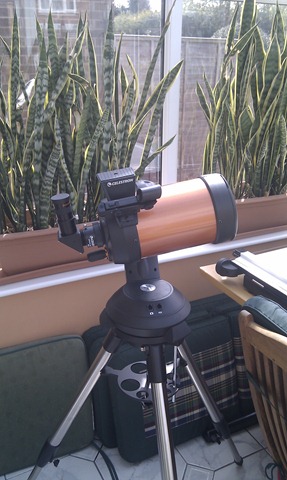 This is a brief overview of my shiny new purchase: a Celestron NexStar 5SE telescope. As an experiment I have also embedded a video review (here), I should also point out that so far cloud cover has meant the only celestial object I have observed is the sun (using the appropriate safety measures).
This is a brief overview of my shiny new purchase: a Celestron NexStar 5SE telescope. As an experiment I have also embedded a video review (here), I should also point out that so far cloud cover has meant the only celestial object I have observed is the sun (using the appropriate safety measures).
I bought my ‘scope from Sherwood’s, who I am happy to recommend for their good prices, and quick and efficient service. My purchase list was as follows:
- Celestron NexStar 5SE (with mains adaptor)
- SLA AstroPower station 12v 7Ah battery pack
- Piggyback mount for my Canon 400D SLR
- Universal camera adaptor and T-mount for similar
- Moon filter
- Baader solar filter film
The mount is powered, the add-on battery pack seemed like the best option for providing that power conveniently. I have a Canon 400D SLR camera which I wanted to use with the telescope, the piggyback mount lets me put the camera on top of the optical tube and simply use it to point the camera at the sky. The T-mount assembly allows me to use the telescope as a camera lens, albeit without auto-focus and aperture.
The solar filter is essential if you want to look at the sun, and I got the impression a moon filter was useful for dimming the brightness of the moon, photographers will know that when photographing the moon the exposure time is as if for a rock sitting in full sun, which is exactly what it is!
The 5SE is a Schmidt-Cassegrain telescope with a 125mm (5 inch) primary mirror, a focal length of 1250mm and an overall F/ratio of 10. “Schmidt-Cassegrain” means that the open end of the tube has a corrector plate (Schmidt’s contribution) and light is focussed by a large concave primary mirror and a smaller convex secondary mirror in the centre of the corrector plate. The image is viewed through an eyepiece in the back of the optical tube, behind the primary mirror. In practical terms it also means the telescope has a very short tube length making it more portable than similarly specified telescopes. The whole assembly is easy to pick up and carry in its deployed state, and the optical tube in particular was well-packed on delivery forming the basis of a useful carrycase.
The telescope is supplied with a 25mm focal length eyepiece which gives a magnification of x50, the maximum useful magnification of the telescope should be x300 with appropriate eyepiece. Focus is achieved by turning a knob on the back plane of the telescope tube, which moves the primary mirror. The eyepiece is attached to a periscope (Star Diagonal in Celestron’s parlance) to give a more comfortable viewing position. The finderscope is a Celestron Star Pointer, which is a non-magnifying window with an LED spot projected to the middle for guiding, it took me a little while to get the hang of this but I can see the benefit of a low magnification finderscope.
The telescope is on a computerized alt-azimuth mount which also includes an equatorial wedge (like the equatorial platform), meaning that the rotational motion of the mount can be made co-axial with that of the earth – allowing un-rotated tracking of objects through the sky for astrophotographic purposes. The controller is a handset device on a cord, in night time operation the telescope can be aligned to the night sky by pointing it to three different stars, after which it will goto any one of a huge catalogue of celestial objects selected using the handset.
The optical tube feels nice and chunky, although the finderscope is a bit plasticky. The piggyback mount attaches using the same mounting holes as the finderscope, the finderscope then bolts back on top, I did a bit of tweaky of the screws along with adjustments on the finderscope to get it aligned. I have achieved fine views of my neighbours chimney pot!
There is a battery compartment in the mount which takes 8xAA batteries, reading on the internet I understand the lifetime for this set is about 30 minutes in operation, which is why I got both a mains adaptor and a 3rd party battery pack. I suspect I’ll mainly use the add-on battery pack for the convenience of fewer trailing leads. The mount doesn’t operate without power, which is a bit of a drawback, the telescope can be tilted but not rotated. The mount sits on top of a nice chunky tripod, to which it is attached by three screws, so in principle you could make yourself a “manualised” version by sitting the scope on a turntable. I have the slightly spurious desire to see a graduated scale on the mount movements. I’m used to using research grade optical equipment and whilst the optics have that feel about them the mount, although functional, does not.
The telescope comes with TheSkyX (First Light edition) planetarium software, and also an application called “NexRemote” which seems to allow you to control the telescope using a virtual version of the handset on screen – this seems a bit pointless to me! Other telescope control software is available, and it appears there is an interface standard. The programmer in me is hankering to write my own controller software!
Overall I’m pleased with my new purchase but desperate for a slightly less cloudy night to try it out properly – no doubt more blog posts to follow once I’ve done this! Even at £650 for the telescope it is cheaper than many lenses for my Canon SLR, although it is a little chastening that John Hadley’s 1721 reflecting telescope had a larger primary mirror.
Update:
After a few weeks of twilight use I thought it might be useful to add a couple of further comments which don’t really make a full new blog post:
1. You can get and set the telescope azimuth and altitude directly using the appropriate entries in the Utilities menu, without alignment these values are based on an assumed initial position of 0,0. During the hours of daylight, when only a very limited number of celestial bodies may be visible, you can carry out a “single body” alignment using the “Solar System Align” option in Alignment. This allows you to enable tracking, and to Goto specified absolute coordinates – useful if you want to survey heights of neighbouring obstructions.
2. The 5SE does not support autoguiding whilst the 6SE and 8SE do. The NexStar range does seem a bit confusing in terms of the facilities available across the range, the 5SE for another example is the only one to have a built-in equatorial wedge.
Here is a video tour, which covers much of what I’ve written above but includes the sound of me tripping over the cat’s water bowl:
Apr 27 2012
Revisions to UK GDP data
The BBC published an article entitled “Viewpoint: Is UK GDP data fit for purpose?” which featured a graph showing the original estimates for quarterly UK GDP growth and current estimates for those same figures. The point being that the original figures are subject to revision which can change figures quite significantly, for example currently we are technically in recession with a GDP growth figure for Q1 2012 of –0.2% (source). But how does this compare with the size of the revisions made to the data?
Here is the graph from the original article:
This is quite nice but there are other ways to display this data, which unfortunately isn’t linked directly to the graph. However, this should not stop an enterprising number-cruncher, there exists software which will allow you to extract the numbers from graphs! I used Engauge Digitizer, which worked fine for me – I had the data I wanted 20 minutes or so after I’d downloaded the software. It does some semi-automatic extraction which makes separating the two different sets of data in the graph on the basis of the colour of the lines quite easy.
This type of approach is not ideal, the sampling interval for the extracted data is not uniform, and not the same for the two datasets, furthermore the labelling of the x-axis is unclear so it’s difficult to tell exactly which quarter is referred to.
I next loaded up the data into Excel for a bit of quick and easy plotting. To address the sampling problem I used the vlookup function to give me data for each series on a quarterly basis. I can then plot interesting things like the difference between the current and original estimates for each quarter, as shown below:
A few spot checks referring back to the original chart can convince us that we have scraped the original data moderately well. The data also fit with the ONS comment on the article:
…looking back over the last 20 quarters, between the first and most recent estimates, the absolute revision (that is, ignoring the +/- sign) is still only 0.4 percentage points.
I calculated this revision average and got roughly the same result.We can also plot the size of revisions made as a function of the current estimate of the GDP growth figure:
This suggests that as the current estimate of growth goes up so does the size of the revision: rises are under-estimated, falls in growth are under-estimated in the first instance although this is not a statistically strong relationship. These quarterly figures on GDP growth seem awfully noisy, which perhaps explains some of the wacky explanations for them (snow, weddings, hot weather etc etc) – they’re wild stabs at trying to explain dodgy data which doesn’t actually have an explanation.
The thing is that the “only 0.4 percentage points” that the ONS cites makes all the difference between being in recession and not being in recession!
Footnotes
I uploaded my spreadsheet here, the figures did not import well.

